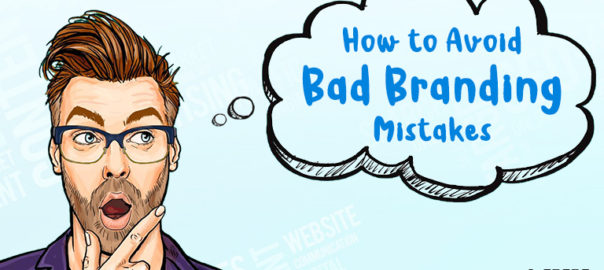When most individuals hear the term “brand,” they immediately think of huge, well-established corporations such as Google, Adidas, or Apple. However, you must remember that these multibillion-dollar corporations were once small businesses, just like any other venture.
Although there are several factors that contribute to a business’s growth, having an effective branding plan is critical to its success. Creating a strong and visible brand is a lengthy process that requires time and effort.
Branding implies seizing every chance to convince people to choose your brand over the other. As a result, all means of communication — not just visual — are critical for strengthening this trust and keeping your brand at the forefront of your customers’ minds.
However, just as strong branding enhances your business’s value, poor branding detracts from it. That’s correct; even the tiniest branding mistakes may have a significant negative impact on your corporation’s brand and image. Let’s look at some of the most typical errors you must avoid while developing your brand strategy:
Lack of a Well-Defined Branding Strategy
To accomplish your business objectives, the first step should be to develop a strategy, especially with regard to your branding. If you enter the process of branding and marketing without a clear concept of what you want to accomplish, you’re likely to miss the point, creating uncertainty for both you and your consumers.
Before you begin developing your brand image, you should have a firm grasp of the idea and tone you wish to convey for your business. Are you a strong and commanding figure? Are you sociable and amusing? Are you a youthful and carefree entity? Whichever route you take, if you’re clear on the style, feeling, and tone you want to accomplish from the start, you’ll be able to develop branded content that accurately represents this.
Paying No Attention to Customer Experience
A strong brand image is unquestionably helpful. It might assist you in developing a favorable image with your consumers and make selling much easier. While branding can contribute to a favorable image for your goods, the experience of the consumer with your product is much more critical.
Unfortunately, many people incorrectly believe that a brand is defined by a logo, an advertisement campaign, or the aesthetics of product packaging. Eventually, your branding is the feeling a buyer has when considering your products. To enhance the customer experience, resolve the concerns of consumers promptly. Establish a timely response to consumers, whether it’s through a live chat feature on your site or by replying to emails within 24 hours.
Inconsistency Across Platforms
To establish a strong brand, you must boost your business as real, legitimate, and precisely who you claim to be. You must have a consistent voice, style, and purpose throughout all of your communication and social media platforms. If you neglect to do so, your consumers will never get a strong feeling for your business. This implies that if you mention something on your brand’s Social Media pages and something else on your website, your customers will be confused as to which is true.
Brand reliability begins with aligning all of your advertising campaigns across your brand’s touchpoints. This encompasses your visual identity, philosophy, beliefs, and business objectives. To assist you in maintaining a high degree of consistency, we propose that you develop a set of business-specific branding style standards. It is a collection of standards in which you may include your preferred color, typography, pictures, logo, and voice tone.
These standards will ensure that anybody generating content for your brand maintains consistency across various platforms.
Choosing Low-Cost Alternatives
When you’re just getting started with your company, it makes perfect sense to be frugal with your spending. While it is prudent to be cost-effective, this does not imply you should forego factors that contribute to the identification and effectiveness of your branding efforts.
If you believe you can get away with having your friend’s cousin create your logo and construct your website at cheap rates, you are mistaken. While this may appear to be a fantastic deal for both parties, it will have a negative impact on your branding strategy in the long run. Whenever it comes to social media, everything is a matter of perspective.
This implies that if you have a low-quality website having fewer features and an unattractive logo, it will reflect poorly on the services provided by your organization. Individuals who are unfamiliar with your company will see them and quickly connect your branding with being poor and unpleasant – a mistake that should be definitely avoided!
It’s good to spend on experienced designers and developers to produce something of exceptional quality, as this will result in the creation of an authentic, professional, and attractive brand to your intended audience.
Integrating Yourself with Your Rivals
While it may be simple to follow patterns whenever it is about branding, if you do so too precisely, you risk being indifferent to the rest of the businesses around you.
While it may be tempting to follow current branding trends, the purpose of effective branding is to differentiate you: to give your brand its unique voice, appearance, and personality. As a result, you must develop your distinctive style, as that’s what will truly differentiate you from your rivals.
Conduct research, determine your differential advantage, and utilize the results to develop a powerful brand image that emphasizes your individuality.
Focusing on Quantity, Not on Quality
Effective branding is not about how often your potential customers see your brand; it is about how they perceive it and the opinions they form about it as a result of what they can see. What counts is that you deliver valuable information to your audience, not how many posts, photos, or clips you publish featuring your brand. Quality should never be sacrificed for quantity in any marketing strategy.
Even though it is a widely held idea that regularly publishing and updating information is a method to differentiate yourself from your rivals, if the frequency of your posts and updates outweighs the quality of your content, it is all in vain. Instead of viewing the content of your brand, consumers look forward to, they’ll come to dislike your business as one that continually appears in their feed or mailbox with nothing significant to say.
This will certainly result in people unsubscribing your brand and discontinuing to connect with you. As a result, it’s critical that you guarantee each content you post with your brand is valuable to your audience.
Ignoring the Significance of Mobile Users
Whenever it’s about digital marketing, there is a growing trend towards mobile device use. Mobile phones currently account for 65 percent of overall digital media consumption and are gaining traction as technology advances and web browsing increases.
Regardless of your primary channel, mobile-friendly content must play a significant role in both your short- and long-term branding strategies.
Conclusion
Utilizing the potential of branding is no different from implementing any other marketing approach. By utilizing analytics, you can ensure that your business avoids costly branding errors. However, increasing awareness and holding the aforementioned guidelines in mind is one of the most effective methods to pave the road for your brand’s success.
Contact Us Today to For Your Branding Needs



